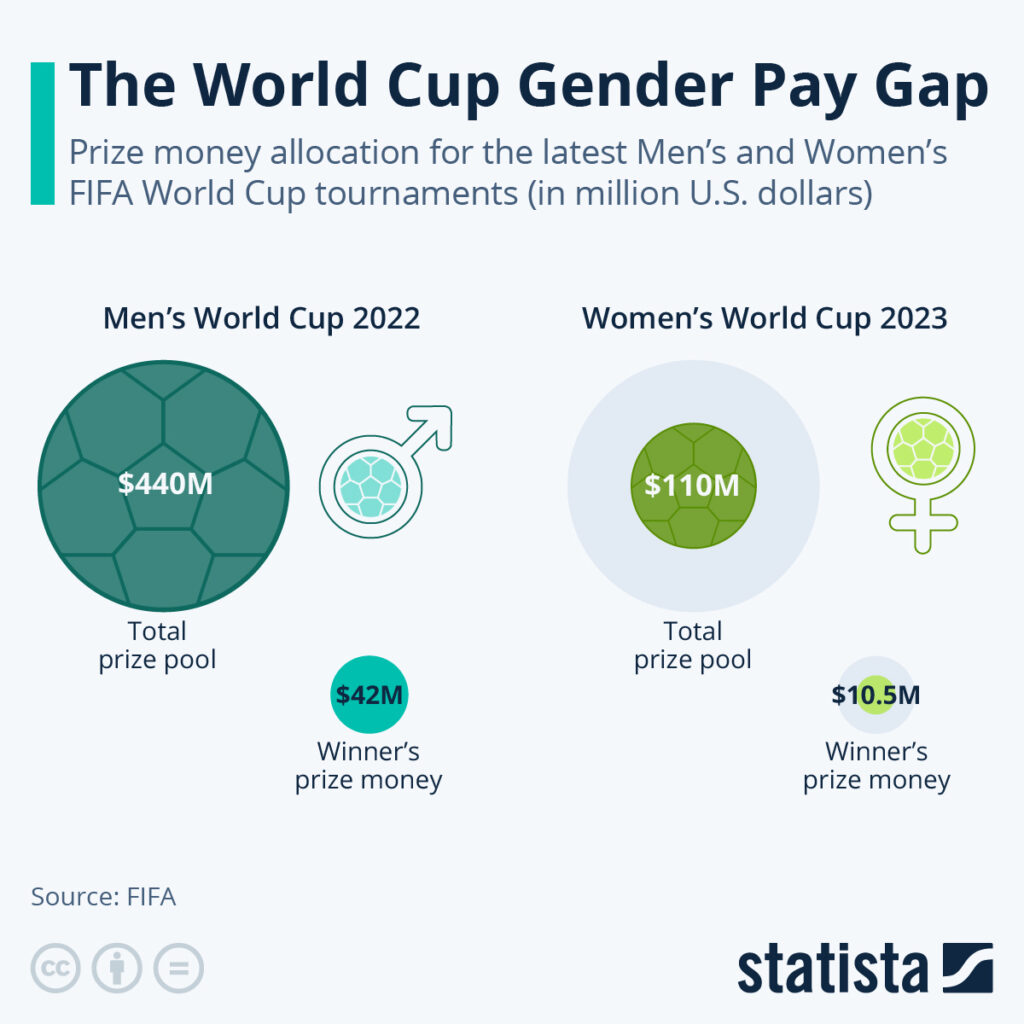Football has become a global phenomenon, loved by millions of fans around the world. From sold-out stadiums to massive broadcasting deals, the sport generates billions every year. However, when it comes to wages, there is a noticeable difference between male and female footballers. Some, like Megan Rapinoe, have pushed for equal pay in the sport. In the United States, her efforts led to the equalisation of salaries for the men’s and women’s national teams in 2022. While this decision was celebrated by many, it wasn’t entirely justified when considering the revenue each team generates. Men’s and women’s football operate in different financial realities, and this difference is naturally reflected in the wages players earn.
The Numbers Speak for Themselves
One of the most famous and successful footballers, Cristiano Ronaldo signed a deal worth €200 million a year with Al-Nassr in Saudi Arabia. That will cover not only his player salary but also his ambassadorial roles for the Saudi league. On the other hand, the best player of women’s football, Aitana Bonmatí, receives around €1 million a year playing for the best team in the world: Barcelona.
This may seem unfair, but the explanation lies in how much cash both sides bring into the sport. Ronaldo isn’t just an athlete; he’s a brand. When Ronaldo plays, viewership goes deep into the millions; his social media following of over 500 million makes him a marketing powerhouse. Sponsors are willing to pay massive sums to have their names associated with him because the exposure they get is unparalleled.
On the other hand, women’s football, while growing rapidly, is still far behind in terms of revenue. The Women’s Super League, for example, signed a historic broadcasting deal worth £24 million over three years. This is a significant milestone but still a fraction of the multi-billion-dollar deals secured by the Premier League or La Liga.
Ticket Prices Show the Difference
If you want to watch a big Champions League match at the Camp Nou, tickets for men’s games can cost at least €150. For a similar game in women’s football, you can find tickets for just €20. This is not because women’s football is less exciting, but because it is still building its fan base and doesn’t have the same level of demand. Lower ticket prices mean less income for clubs, which affects how much they can pay their players.
Sponsorships and Global Reach
Another aspect where this difference is crystal clear is in the sponsorship deals. For instance, Ronaldo has massive endorsement contracts with companies like Nike, Clear Shampoo, and Binance, among others. These deals cost millions because the brands know that once they associate themselves with him, they are guaranteed to be exposed to the whole world. Ronaldo’s games are watched by billions of people, and his posts on social media garner millions of likes and shares.
Sponsorships, too, are getting better in women’s football, with Nike, Adidas, and Visa raising the bar higher for investments into the sport. However, the scale remains smaller because the audience is still developing. For example, the 2022 men’s FIFA World Cup attracted over 5 billion viewers, while the 2023 Women’s World Cup reached around 2 billion. Although this is a huge number, it’s still less than half of what the men’s tournament achieved.
Logical Economics, Not Unfair Practices
The wage gap in football is not due to any unfair practices; rather, it reflects how market dynamics work: players’ salaries are determined by how much money their leagues and teams pull in. Naturally, men’s football brings in more money due to the colossal TV deals, packed stadiums, and a long-established presence in every corner of the globe. Real Madrid, Manchester United, and Bayern Munich are globally recognised brands; they move fans and sponsors from every part of the world.
Women’s football, while on the rise, still trails behind. Further, there lies a great big gap in terms of money earned through ticketing, broadcasting rights, and finally, sponsorship, since these three significantly impact the way clubs are to pay their women. Take, for instance, the Barcelona women’s team that achieved unbelievable success and crowds-never-seen record-breaking attendance figures, their revenues stood at a fraction of what was generated by the men.
A Promising Future
Despite this gap, women’s football is growing incredibly. The 2023 Women’s World Cup set new records for viewership, and more fans are attending matches than ever before. Clubs and leagues are beginning to invest more in their women’s teams, recognising their potential for growth.
Sponsorship deals are also increasing. For example, Nike created special campaigns for the Women’s World Cup, and Visa has made a multi-year commitment to support the Women’s Champions League. These steps show that brands see the long-term potential of the women’s game, and as the audience grows, so will the financial opportunities.
While the wage gap is likely to remain for the foreseeable future, the trajectory of women’s football is promising. The sport is gaining more fans, more investment, and more recognition. Over time, as revenues increase, the gap will naturally begin to close. This won’t happen overnight, but the growth we’re seeing now suggests that the future of women’s football is brighter than ever.
For now, the difference in wages reflects the reality of how much money each side of the sport generates. It’s not about fairness or unfairness:it’s about the numbers. And as those numbers continue to rise for women’s football, the players, clubs, and fans will all benefit.

https://www.statista.com/chart/27871/soccer-football-gender-gap-prize-money

